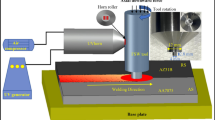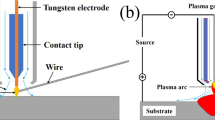Abstract
In the automotive industry, the demand for ultra-high-strength steel is increasing due to the CO2 emission and safety regulations. Hot-press forming (HPF) steels are a type of boron-alloyed high-strength steel fabricated via hot-press forming, which enables both high strength and elongation. Because HPF is conducted at high temperatures (900–950 °C) for a few minutes, its surface is coated with Al–Si or Zn to prevent surface oxidation and decarburizing. However, the coating layer often influences the properties of the welds. In this study, friction stir spot welding (FSSW) is used to weld dissimilar metals, i.e., an Al alloy and Al–Si-coated HPF steel. The effects of Al–Si coating on the mechanical and metallurgical properties of the hook formation on the weld are investigated. The shape of the hook, which is formed during FSSW, changes from bent to straight shape due to the presence of Al–Si and the HPF process. The joint strength of the straight hook-shaped specimens is demonstrated to be lower than that of the bent hook-shaped specimens. This difference in strength is because the hard Fe–Al–Si intermetallic (IMC) layer on the outer surface of the hook disturbs the bending of the hook during the welding. On the outer surface of the hook, a Fe–Al–Si IMC layer of chemical composition similar to that of the coating layer formed during HPF is observed. This formation is different from the inner surface of the hook, wherein a thin Fe–Al IMC layer is reconstructed between aluminum and steel. Thus, the hard Fe–Al–Si intermetallic layer transformed during the HPF process is the primary cause of the straight hook shape.












Similar content being viewed by others
References
Stanford K (2017) Lightweighting boosts vehicle safety. Alum Int Today 30(6):10–12
Fan DW, Kim HS, De Cooman BC (2009) A review of the physical metallurgy related to the hot press forming of advanced high strength steel. Steel Res Int 80(3):241–248
Karbasian H, Tekkaya AE (2010) A review on hot stamping. J Mater Process Technol 210(15):2103–2118
Kim C, Kang M, Park Y (2011) Laser welding of Al-Si coated hot stamping steel. Procedia Eng 10:2226–2231
Kim C-H, Choi J-K, Kang M-J, Park Y-D (2010) A study on the CO2 laser welding characteristics of high strength steel up to 1500 MPa for automotive application. J Achiev Mater Manuf Eng 39(1):79–86
Kang M, Kim C (2011) Analysis of laser and resistance spot weldments on press-hardened steel, Mater Sci Forum. Trans Tech Publ 2011(99):202–205
Sakayama T, Naito Y, Miyazakki Y, Nose T, Murayma G, Saita K, Oikawa H (2013) Dissimilar metal joining technologies for steel sheet and aluminum alloy sheet in auto body. Nippon Steel Techn Rep 103:91–98
Meschut G, Janzen V, Olfermann T (2014) Innovative and highly productive joining technologies for multi-material lightweight car body structures. J Mater Eng Perform 23(5):1515–1523. https://doi.org/10.1007/s11665-014-0962-3
Martinsen K, Hu SJ, Carlson BE (2015) Joining of dissimilar materials. CIRP Ann 64(2):679–699. https://doi.org/10.1016/j.cirp.2015.05.006
Agudo L, Eyidi D, Schmaranzer CH, Arenholz E, Jank N, Bruckner J, Pyzalla AR (2007) Intermetallic Fe x Al y-phases in a steel/Al-alloy fusion weld. J Mater Sci 42(12):4205–4214
He X, Pearson I, Young K (2008) Self-pierce riveting for sheet materials: state of the art. J Mater Process Technol 199(1-3):27–36. https://doi.org/10.1016/j.jmatprotec.2007.10.071
Han L, Chrysanthou A (2008) Evaluation of quality and behaviour of self-piercing riveted aluminium to high strength low alloy sheets with different surface coatings. Mater Des 29(2):458–468. https://doi.org/10.1016/j.matdes.2006.12.020
Dilthey U, Stein L (2006) Multimaterial car body design: challenge for welding and joining. Sci Technol Weld Join 11(2):135–142
Kimapong K, Watanabe T (2004) Friction stir welding of aluminum alloy to steel. Weld J 83(10):277s–282s
Taban E, Gould JE, Lippold JC (2010) Dissimilar friction welding of 6061-T6 aluminum and AISI 1018 steel: properties and microstructural characterization. Mater Des 31(5):2305–2311
Kusuda Y (2013) Honda develops robotized FSW technology to weld steel and aluminum and applied it to a mass-production vehicle. Ind Robot Int J 40(3):208–212
Mishra RS, Ma Z (2005) Friction stir welding and processing. Mater Sci Eng R Res 50(1-2):1–78
Santella M, Hovanski Y, Pan T-Y (2012) Friction stir spot welding (FSSW) of advanced high strength steel (AHSS). SAE Int J Mater Manuf 5(2):382–387
Hovanski Y, Santella ML, Grant GJ (2007) Friction stir spot welding of hot-stamped boron steel. Scr Mater 57(9):873–876. https://doi.org/10.1016/j.scriptamat.2007.06.060
Hong SH, Sung S-J, Pan J (2015) Failure mode and fatigue behavior of dissimilar friction stir spot welds in lap-shear specimens of transformation-induced plasticity steel and hot-stamped boron steel sheets. J Manuf Sci Eng 137(5):051023
da Silva AAM, Aldanondo E, Alvarez P, Arruti E, Echeverría A (2013) Friction stir spot welding of AA 1050 Al alloy and hot stamped boron steel (22MnB5). Sci Technol Weld Join 15(8):682–687. https://doi.org/10.1179/136217110x12785889549462
Kang M, Kim C, Lee J (2012) Weld strength of laser-welded hot-press-forming steel. J Laser Appl 24(2):022004
Badarinarayan H, Shi Y, Li X, Okamoto K (2009) Effect of tool geometry on hook formation and static strength of friction stir spot welded aluminum 5754-O sheets. Int J Mach Tools Manuf 49(11):814–823. https://doi.org/10.1016/j.ijmachtools.2009.06.001
Bozzi S, Helbert-Etter AL, Baudin T, Criqui B, Kerbiguet JG (2010) Intermetallic compounds in Al 6016/IF-steel friction stir spot welds. Mater Sci Eng A 527(16):4505–4509. https://doi.org/10.1016/j.msea.2010.03.097
Wang T, Sidhar H, Mishra RS, Hovanski Y, Upadhyay P, Carlson B (2018) Friction stir scribe welding technique for dissimilar joining of aluminium and galvanised steel. Sci Technol Weld Join 23(3):249–255
Wang T, Sidhar H, Mishra RS, Hovanski Y, Upadhyay P, Carlson B (2019) Effect of hook characteristics on the fracture behaviour of dissimilar friction stir welded aluminium alloy and mild steel sheets. Sci Technol Weld Join 24(2):178–184. https://doi.org/10.1080/13621718.2018.1503801
Xu RZ, Cui SL, Li H, Hou YX, Wei ZC (2019) Improving hook characterization of friction stir lap welded Al alloy joint using a two-section stepped friction pin. Int J Adv Manuf Technol 102(9):3739–3746
Derazkola HA, Khodabakhshi F (2019) Intermetallic compounds (IMCs) formation during dissimilar friction-stir welding of AA5005 aluminum alloy to St-52 steel: numerical modeling and experimental study. Int J Adv Manuf Technol 100(9-12):2401–2422
Chen YC, Komazaki T, Tsumura T, Nakata K (2008) Role of zinc coat in friction stir lap welding Al and zinc coated steel. Mater Sci Technol 24(1):33–39
Ratanathavorn W, Melander A (2017) Influence of zinc on intermetallic compounds formed in friction stir welding of AA5754 aluminium alloy to galvanised ultra-high strength steel. Sci Technol Weld Join 22(8):673–680
Santella M, Hovanski Y, Frederick A, Grant G, Dahl M (2010) Friction stir spot welding of DP780 carbon steel. Sci Technol Weld Join 15(4):271–278
Fan DW, Kim HS, Oh J-K, Chin K-G, De Cooman B (2010) Coating degradation in hot press forming. ISIJ Int 50(4):561–568
Shome M, Tumuluru M (2015) Welding and joining of advanced high strength steels (AHSS), vol 85. Elsevier
Yoon J, Kim C, Rhee S (2018) Compensation of vertical position error using a force–deflection model in friction stir spot welding. Metals 8(12):1049
Yoon J, Kim C, Rhee S (2019) Performance of plunge depth control methods during friction stir welding. Metals 9(3):283
Yang Q, Mironov S, Sato YS, Okamoto K (2010) Material flow during friction stir spot welding. Mater Sci Eng A 527(16):4389–4398. https://doi.org/10.1016/j.msea.2010.03.082
Su P, Gerlich A, North T, Bendzsak G (2007) Intermixing in dissimilar friction stir spot welds. Metall Mater Trans A 38(3):584–595
Ohishi K, Sakamura M, Ota K, Fujii H (2016) Novel dissimilar spot welding of aluminium alloy and steel sheets by friction stirring. Weld Int 30(2):91–97. https://doi.org/10.1080/09507116.2014.921088
Funding
This research was supported by a grant from the Ministry of Trade, Industry and Energy, Republic of Korea.
Author information
Authors and Affiliations
Corresponding author
Additional information
Publisher’s note
Springer Nature remains neutral with regard to jurisdictional claims in published maps and institutional affiliations.
Rights and permissions
About this article
Cite this article
Kang, M., Yoon, J. & Kim, C. Hook formation and joint strength in friction stir spot welding of Al alloy and Al–Si-coated hot-press forming steel. Int J Adv Manuf Technol 106, 1671–1681 (2020). https://doi.org/10.1007/s00170-019-04716-9
Received:
Accepted:
Published:
Issue Date:
DOI: https://doi.org/10.1007/s00170-019-04716-9




